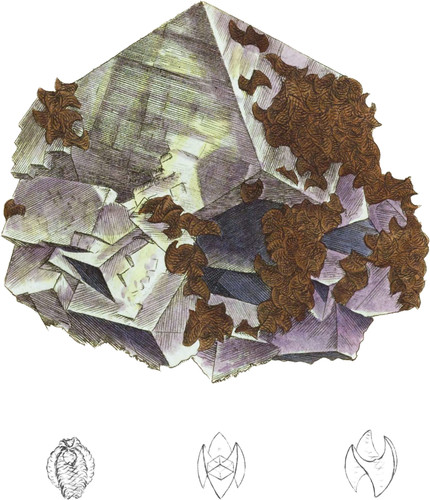 Enlarge
Enlarge
British Mineralogy
Bronzed Pearlspar
Since I published the Pearlspar, (tab. 19) this substance seems somewhat better known; and it appears according to some authors, that Mr. Bergman considered Manganese as a component part instead of Magnesia. I believe, however, that the former may sometimes accidentally enter into the combination, although I think it is in a great measure beholden to the Magnesia fur its pearly and often metallic lustre, and to the degree of oxygenization of the Iron it contains for its colour; and it may be proper here to observe, that most of the lenticular crystals of what is commonly called Spathose Iron Ore are very nearly related to it in these peculiarities.
The rich bronzed appearance of this specimen, and the curvature of the crystals being nearly in the last state, tempted me to figure it as another lesson on the curvature of crystals: tab. 423 showing a curvature of the cube, this a curvature of the rhomb, the lateral angles of which being alternately curved, make a strange figure: see the lower outlines. The right hand figure shows the complete crystal, but little more than half is formed in the groups upon the specimen. The middle crystal shows the six lateral angles lengthened out in a front view, with the rhomb as a nucleus to show its place. The left hand figure (almost the extreme of tins mode of curvature) is from another specimen. I have a specimen where these are combined in threes and fours, and almost plumose in appearance. These crystals are whiter within, and therefore show their relation to Magnesian Carbonate of Lime; and I have some from Tavistock by favour of my ingenious friend Mr. John Taylor, that have a very golden hue and metallic lustre.—The difference of the aggregation of the nuclei, &c. to form the crystals, may depend upon the quick or slow evaporation of the menstruum in which they formed, depending upon the temperature.
The description and figures of tab. 19, I found from examining more perfect specimens are incorrect, being taken from views of only parts of crystals.

